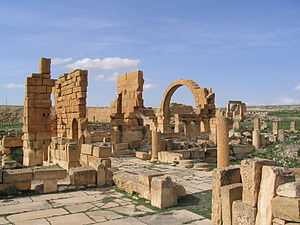Haïdra
| Haïdra حيدرة | |
|---|---|
|
Archaeology site of Haidra | |
 Haïdra Location in Tunisia | |
| Coordinates: 35°34′N 8°28′E / 35.567°N 8.467°E | |
| Country |
|
| Governorate | Kasserine Governorate |
| Government | |
| • Governor | Atef Boughatas |
| • Mayor | Jamel Saâdi |
| Population (2004) | |
| • Total | 3,100 |
| • Ethnicities | Arab |
| • Religions | Islam |
| Time zone | CET (UTC1) |
| Postal code | 1221[1] |
Haïdra (Arabic: حيدرة) is a municipality in western Tunisia, containing the ruins of Ammaedara, one of the oldest Roman cities in Africa.
Ammaedara was on the border between the valleys and the Berber tribes and was part of the Roman province of Byzacena.
Its ruins include mausoleums, Byzantine fortresses, underground baths, and a church.[2]
Excavation of what has been called the Church of Melleus in the centre of Ammaedara has brought to light the tombs of some bishops of the see. In addition, documentary records survive of Eugenius, a bishop of Ammaedara who participated in the Council of Carthage of 255, which discussed the question of the lapsi, and of Speratus and Crescentianus, representing respectively the Catholics and the Donatists of the city, who took part in the Conference of Carthage of 411. Later Catholic bishops were Hyacinthus and Melleus, both of the second half of the 6th century.[3][4][5][6][7][8]
No longer a residential bishopric, Ammaedara is today listed by the Catholic Church as a titular see.[9]
Notable people
- Pr Ahmed Jdey (10 June 1951 – 20 July 2012) was a writer, historian, and professor.[10]
References
- ↑ Postal code of Haïdra, GeoPostcodes
- ↑ Richard Stillwell, ed. Princeton Encyclopedia of Classical Sites, 1976: "Ammaedara (Haidra), Tunisia"
- ↑ Stefano Antonio Morcelli, Africa christiana, Volume I, Brescia 1816, pp. 74–75
- ↑ Baratte François, Bejaoui Fathi, Un évêque horloger dans l'Afrique byzantine : Hyacinthe d'Ammaedara, in Comptes-rendus des séances de l'Académie des Inscriptions et Belles-Lettres, 148e année, N. 3, 2004. pp. 1121–1151
- ↑ Duval Noël, Les églises d'Haïdra (Églises dites de Melléus et de Candidus et "chapelle vandale"). Recherches franco-tunisiennes de 1969 (Relevés et dessins de J.-M. Gassend), in Comptes-rendus des séances de l'Académie des Inscriptions et Belles-Lettres, 113e année, N. 3, 1969. pp. 409–436
- ↑ Duval Noël, L'église de l'évêque Melleus à Haïdra (Tunisie): la campagne franco-tunisienne de 1967, in Comptes-rendus des séances de l'Académie des Inscriptions et Belles-Lettres, 112e année, N. 2, 1968. pp. 221–244
- ↑ J. Mesnage L'Afrique chrétienne, Paris 1912, pp. 77–79
- ↑ Ammaedara (website of the Associazione storico-culturale di Sant'Agostino)
- ↑ Annuario Pontificio 2013 (Libreria Editrice Vaticana 2013 ISBN 978-88-209-9070-1), p. 831
- ↑ (Arabic) Ahmed Jdey biography, kissas.org
Coordinates: 35°34′N 8°28′E / 35.567°N 8.467°E
